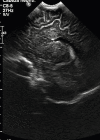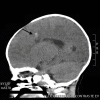Multiple Cavernous Malformation Syndrome in an Infant: A Case Report
- PMID: 39100028
- PMCID: PMC11296396
- DOI: 10.7759/cureus.63750
Multiple Cavernous Malformation Syndrome in an Infant: A Case Report
Abstract
Cerebral cavernomas belong to a group of vascular lesions characterized by varying structural properties and presentations. Clinical manifestations vary among patients and are particularly influenced by age, posing challenges in diagnosis and treatment. Here, we present a pediatric case of a cerebral cavernoma, which is very rare. We further aim to emphasize the importance of a good physical examination.
Keywords: angioma; cavernous malformation; cerebral cavernous; familial cavernous malformations; syndrome.
Copyright © 2024, Castellaro et al.
Conflict of interest statement
Human subjects: Consent was obtained or waived by all participants in this study. Conflicts of interest: In compliance with the ICMJE uniform disclosure form, all authors declare the following: Payment/services info: All authors have declared that no financial support was received from any organization for the submitted work. Financial relationships: All authors have declared that they have no financial relationships at present or within the previous three years with any organizations that might have an interest in the submitted work. Other relationships: All authors have declared that there are no other relationships or activities that could appear to have influenced the submitted work.
Figures






Similar articles
-
Novel Development of a Large Cerebral Cavernous Malformation in an Adolescent With a History of Familial Cerebral Cavernous Malformation Syndrome.Cureus. 2024 Jan 19;16(1):e52591. doi: 10.7759/cureus.52591. eCollection 2024 Jan. Cureus. 2024. PMID: 38371143 Free PMC article.
-
Frequency of retinal cavernomas in 60 patients with familial cerebral cavernomas: a clinical and genetic study.Arch Ophthalmol. 2006 Jun;124(6):885-6. doi: 10.1001/archopht.124.6.885. Arch Ophthalmol. 2006. PMID: 16769843
-
Cerebral cavernous malformation in a child leading to a fatal subarachnoid hemorrhage - "silent but sinister:" A case report and literature review.Surg Neurol Int. 2021 Jun 7;12:253. doi: 10.25259/SNI_248_2021. eCollection 2021. Surg Neurol Int. 2021. PMID: 34221584 Free PMC article.
-
Intracranial extra-axial cavernous (HEM) angiomas: tumors or vascular malformations?J Neuroradiol. 2002 Jun;29(2):91-104. J Neuroradiol. 2002. PMID: 12297731 Review.
-
Giant cerebral cavernous malformation in a newborn: a rare case report and review of literature.Childs Nerv Syst. 2024 Jul;40(7):2215-2221. doi: 10.1007/s00381-024-06401-z. Epub 2024 Apr 12. Childs Nerv Syst. 2024. PMID: 38607549 Review.
References
-
- Cerebral cavernous malformations. Incidence and familial occurrence. Rigamonti D, Hadley MN, Drayer BP, Johnson PC, Hoenig-Rigamonti K, Knight JT, Spetzler RF. N Engl J Med. 1988;319:343–347. - PubMed
-
- Truncating mutations in CCM1, encoding KRIT1, cause hereditary cavernous angiomas. Laberge-le Couteulx S, Jung HH, Labauge P, et al. Nat Genet. 1999;23:189–193. - PubMed
-
- Cavernous malformations: natural history, diagnosis and treatment. Batra S, Lin D, Recinos PF, Zhang J, Rigamonti D. Nat Rev Neurol. 2009;5:659–670. - PubMed
-
- The natural history of familial cavernous malformations: results of an ongoing study. Zabramski JM, Wascher TM, Spetzler RF, et al. J Neurosurg. 1994;80:422–432. - PubMed
Publication types
LinkOut - more resources
Full Text Sources
